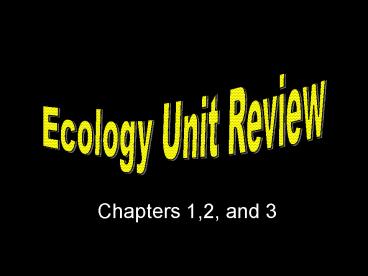Chapters 1,2, and 3 - PowerPoint PPT Presentation
1 / 47
Title:
Chapters 1,2, and 3
Description:
Chapters 1,2, and 3 – PowerPoint PPT presentation
Number of Views:34
Avg rating:3.0/5.0
Title: Chapters 1,2, and 3
1
Ecology Unit Review
- Chapters 1,2, and 3
2
What is Ecology?
- The study of how living things interact with one
another and within their environment.
3
ORGANISMS
4
(No Transcript)
5
Levels of Organization
Organism
6
(No Transcript)
7
Changes in Population Size
Studying Populations
- Populations can change in size when new members
join the population or when members leave the
population.
8
Describe the niche of an organism.
9
Figure 4-5 Three Species of Warblers and Their
Niches
Section 4-2
Cape May Warbler Feeds at the tips of
branches near the top of the tree
Bay-Breasted Warbler Feeds in the middle part of
the tree
Spruce tree
Yellow-Rumped Warbler Feeds in the lower part of
the tree and at the bases of the middle branches
10
Lynx chasing Snowshoe Hare
11
(No Transcript)
12
What is symbiosis?
- A relationship between two organisms in which at
least one organisms benefits.
13
Which symbiotic relationship results with one
species benefiting and one being harmed?
- Parasitism
14
Which symbiotic relationship results with both
species benefiting?
- mutualism
15
Which symbiotic relationship results with one
species benefiting and the other doesnt really
care?
16
(No Transcript)
17
(No Transcript)
18
Producers
19
Herbivores
20
Carnivores
21
Omnivore
22
SCAVENGERS
23
DECOMPOSERS
24
Food Chains and Food Webs
- Energy Flow in Ecosystems
- The movement of energy though an ecosystem can be
shown in diagrams called food chains and food
webs.
25
(No Transcript)
26
Carnivore/ Omnivore
0.1 kcal
1kcal
10 kcal
Herbivore
100 kcal
27
- Cycles of Matter
28
- Cycles of Matter
29
- Cycles of Matter
30
Whats so special about legume roots?
31
Continental Drift
- Biogeography
- One factor that has affected how species are
distributed is the motion of Earths continents.
32
Relating Cause and Effect
- Biogeography
- Identify three causes of dispersal
Causes
Wind
Effect
Dispersal of species
Water
Living things, including humans
33
Limits to Dispersal
- Biogeography
- Climate determines the distribution of species on
different parts of the mountain.
34
What are exotic species?
- An organism that is carried from one location to
another by people.
35
(No Transcript)
36
What are the three main categories of
environmental issues?
- RESOURCE USE
- POPULATION GROWTH
- POLLUTION
37
- RENEWABLE
- NONRENEWABLE
38
Managing Forests
- Forests and Fisheries
- Clear-cutting involves cutting down all the trees
in an area at once. Selective cutting involves
cutting down only some trees.
39
CLEAR CUTTING
ADVANTAGES DISADVANTAGES
- Quick
- Cheap
- Safer for loggers
- Ecosystem changes
- Soil erosion
- Soil washed into streams
40
MANAGING FISHERIES
- FISHING LIMITS
- Ban the fishing of certain species and setting a
limit to the number or size of fish. - FISHING METHODS
- Use larger mesh size nets
- AQUACULTURE
- Humans raise fish and other aquatic organisms
- NEW RESOURCES
- Monkfish, tile fish, tilapia
41
What is biodiversity?
- The number of different species in an area.
42
How do sea otters help keep their ecosystem
balance?
43
Factors Affecting Biodiversity
- Biodiversity
- Factors that affect biodiversity in an ecosystem
include area, climate, and diversity of niches.
44
What is the difference between threatened,
endangered and extinct?
Threatened
Endangered
Extinct
45
What are four causes of extinction?
- Habitat Destruction
- Poaching
- Pollution
- Exotic Species
46
What are three ways of protecting biodiversity?
- Captive Breeding
- Laws and Treaties
- Habitat Preservation
47
(No Transcript)































